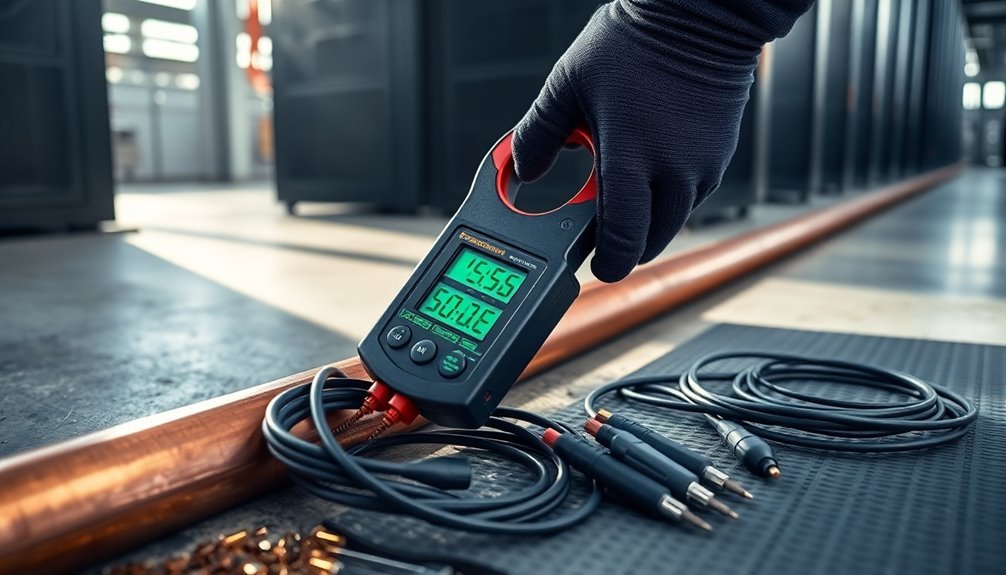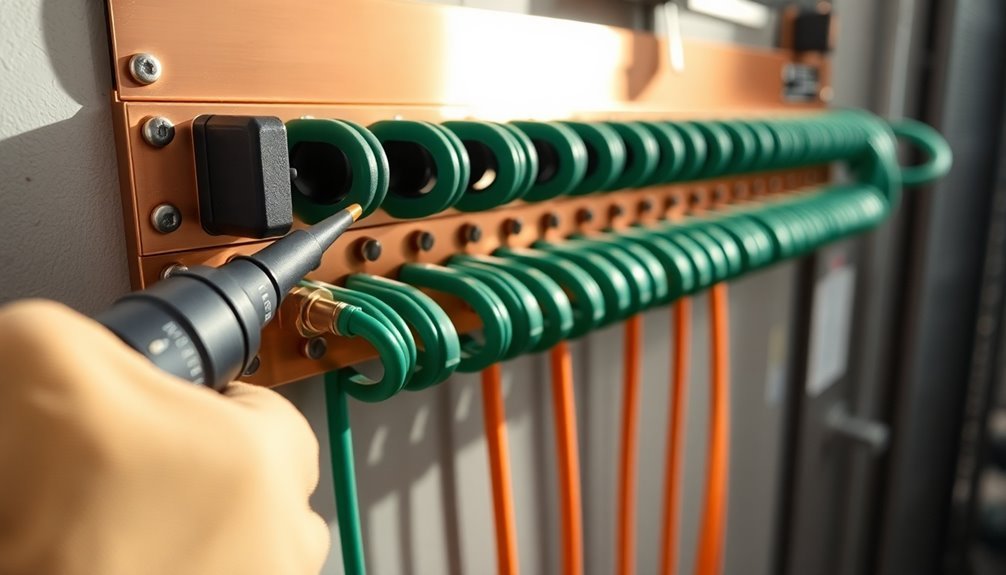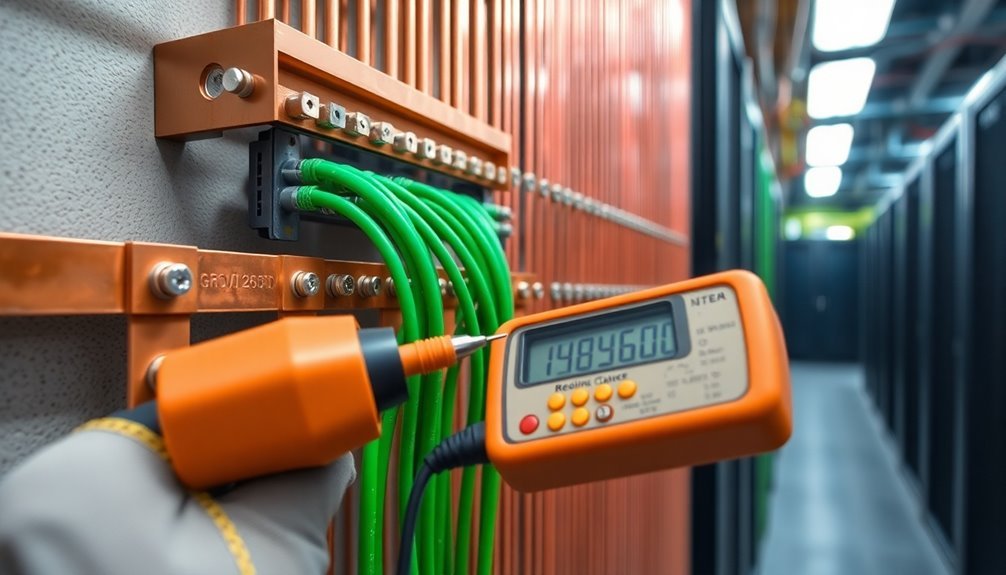When conducting data center grounding audits, you'll want to focus on five essential areas. Start by performing thorough site assessments to measure soil resistivity and identify potential challenges. Next, verify all equipment bonding connections using reliable testing methods like the 4-terminal tester. Don't forget to measure ground resistance using the Fall-of-Potential method for accurate results. You should also inspect your Signal Reference Grid (SRG) to confirm proper bonding to the copper perimeter loop. Finally, review your documentation to confirm compliance with NEC Article 250 and other industry standards. These fundamentals will set you up for a thorough evaluation of your facility's grounding system.
Comprehensive Grounding System Assessment

For data center safety and reliability, a thorough grounding system assessment forms the foundation of an effective electrical infrastructure. You'll need to start by identifying your facility's specific grounding requirements, including soil resistivity measurements and electrical load analysis.
Conduct a detailed site assessment to spot potential challenges that could affect your grounding system's performance. Maintaining uniform conductor spacing throughout the grid installation ensures optimal current distribution.
When evaluating your grounding system, you'll want to focus on key components: the grounding electrode system, conductors, bonding connections, and the Signal Reference Grid (SRG). Use specialized testing methods like four-wire measurements and phase angle analysis to verify system integrity.
Don't forget to examine your grounding bus bar systems, ensuring the Master Grounding Bus Bar (MGB) and Rack Grounding Bus Bars are properly connected and maintained.
Pay special attention to aisle containment areas, as they require specific grounding considerations. Check that all metallic components within these zones are properly bonded and maintain the same electrical potential.
You'll also need to verify compliance with NEC Article 250 guidelines and confirm that your data center ground remains separate from the electrical distribution ground, connected only through a single bonding jumper.
Equipment Bonding Verification Methods
Through systematic verification methods, you'll need to guarantee proper equipment bonding across your data center's infrastructure. Start with visual inspections to confirm all equipment connections to grounding points, then use a multimeter to perform continuity testing between equipment and ground. Modern optical network hardware like MPO connectivity systems should be properly integrated into your grounding infrastructure.
You'll want to examine your grounding bus bars carefully, verifying secure connections to the main grounding system. Check that equipment frames are properly bonded to rack or cabinet grounding systems, and verify that all metallic components maintain solid connections to the grounding network.
Test your system's effectiveness using specialized equipment. Deploy a ground resistance tester to measure system resistance, and conduct impedance testing to confirm specifications are met. Don't forget to check for electromagnetic interference, which can indicate grounding issues.
Your verification process must align with multiple compliance standards. Make sure your bonding methods meet NEC requirements, TIA-607-B specifications, and relevant IEEE standards.
You'll also need to verify compliance with ISO/IEC guidelines and local building codes. Document all test results and maintain regular testing schedules to verify that your equipment bonding remains effective and compliant over time.
Ground Resistance Testing Protocols

When establishing ground resistance testing protocols, you'll need to implement multiple testing methods to guarantee your data center meets critical safety standards. Your primary goal should be achieving a ground resistance of 5.0 ohms or less, as recommended by NFPA and IEEE for sensitive equipment facilities.
Start with the Fall-of-Potential method, as it's the most reliable way to measure ground electrode resistance. You'll use a 4-terminal tester to inject current and measure potential at various points. The test stakes must be placed 20 meters apart in a straight line for accurate measurements.
For quick assessments, you can employ the clamp-on method, which doesn't require system disconnection but includes bond-to-ground measurements in its readings.
Consider factors that affect your readings: doubling electrode length can reduce resistance by 40%, while electrode spacing must be carefully planned to avoid interference. You'll need to conduct soil resistivity tests using the Wenner Four-Pin method before finalizing your grounding system design.
Remember to document all test results and perform regular audits. If you're testing specific system components, use selective ground testing with one clamp and two stakes to isolate measurements. This approach helps you identify potential issues in individual sections of your grounding system.
Signal Reference Grid Inspection
A robust Signal Reference Grid (SRG) inspection program safeguards your data center's critical operations against electrical hazards and equipment failures. When inspecting your SRG, you'll need to verify proper bonding to the 4/0 copper perimeter loop at 6-foot intervals using #6 AWG bare copper conductors.
Start your inspection by measuring continuity between all grounding points – if you find resistance exceeding 1 ohm, you'll need to recheck your connections. Creating an equi-potential grounding system helps establish a reliable signal reference point for data transfers. Don't forget to verify that every third access floor pedestal is properly bonded to the SRG with a #6 AWG concentric copper conductor.
| Inspection Focus | What to Check | Action Required |
|---|---|---|
| Visual Analysis | Bond integrity | Verify connections to perimeter loop |
| Resistance Testing | Continuity readings | Measure between points (<1 ohm) |
| Equipment Bonding | Chassis to rack path | Trace grounding path completely |
Remember to document any hybrid bonds at devices and inspect shielded cable terminations to prevent ground loops. You'll want to guarantee compliance with FIPS 94 and ANSI/J-STD-607 standards while maintaining the equipotential plane across your entire data center floor space.
Documentation and Compliance Review

Keeping up with thorough documentation and compliance reviews stands at the core of effective data center grounding audits. You'll need to maintain extensive records that include detailed schematics, testing results, and maintenance histories while ensuring they align with current industry standards and regulatory requirements.
When conducting documentation reviews, focus on verifying that your grounding system records are complete and up-to-date, covering everything from electrode systems to bonding specifications. Strategic data infrastructure planning helps optimize the documentation process for long-term effectiveness. You should regularly assess your compliance with safety regulations and maintain proper training records for personnel handling grounding tasks.
Here are the essential components you must verify during documentation reviews:
- Current schematics and diagrams showing all grounding system components, including conductor paths and bonding points
- Records of soil resistivity measurements, grounding resistance tests, and periodic inspection results
- Documentation of aisle containment modifications and their impact on the overall grounding system
- Evidence of compliance with industry standards, including risk assessments and mitigation strategies
Remember to identify any gaps in your documentation and address them promptly.
Your final audit report should outline findings and provide clear recommendations for improving both documentation practices and compliance measures.
Frequently Asked Questions
How Often Should Thermal Imaging Be Performed on Grounding Connections?
You'll need to perform thermal imaging on grounding connections at least annually, but you should also conduct scans after new installations, major upgrades, and as part of your regular preventive maintenance program.
Can Existing Lightning Protection Systems Be Integrated With New Grounding Installations?
Yes, you can integrate existing lightning protection systems with new grounding installations. You'll need to guarantee proper bonding to a common equipotential ground and maintain compliance with NFPA 780 and IEEE standards.
What Impact Does Soil Composition Have on Ground Resistance Measurements?
Your soil's composition directly affects ground resistance: moisture content, temperature, soil type, and depth all impact readings. You'll get lower resistance with moist, mineral-rich soil and higher resistance with dry, sandy compositions.
Are Wireless Devices Allowed Near Sensitive Grounding Measurement Equipment?
You shouldn't use wireless devices near grounding measurement equipment, as they can cause electromagnetic interference and corrupt your readings. It's best to maintain distance or turn off devices during measurements.
How Do Seasonal Weather Changes Affect Data Center Grounding Performance?
Your data center's grounding performance will fluctuate with seasonal changes. You'll notice higher impedance during dry seasons and winter frost, while moisture levels and soil temperature variations can substantially impact your system's effectiveness year-round.
In Summary
You'll get the most value from your data center grounding audit by following these five critical steps systematically. If you're diligent about evaluating your thorough grounding system, verifying equipment bonding, testing ground resistance, inspecting your signal reference grid, and reviewing documentation for compliance, you'll maintain maximum protection for your facility. Don't skip any steps – each one plays an essential role in electrical safety.





Leave a Reply